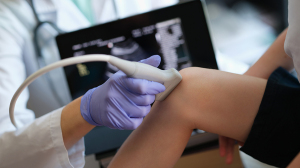Beckman Institute awarded $2 million to develop 3D ultrasound 'clip on' device for 2D imagers
by
John R. Fischer, Senior Reporter | October 18, 2022

The Beckman Institute has received $2 million to fund the development of a 3D ultrasound 'clip on' device for 2D probes.
Because it is 3D, interpreting 2D images of the human body can be difficult and any adjustments in probe placement or body posture risks altering the size of objects in scans.
Researchers at the Beckman Institute for Advanced Science and Technology in Illinois have found a way around these issues, proposing a solution that “clips on” to and adds 3D capabilities to the majority of 2D ultrasound probes.
The National Institute of Biomedical Imaging and Bioengineering at the National Institutes of Health have provided the group with a four-year, $2 million award to fund its development.
Named FASTER, the solution is designed as a low-cost alternative for ultrafast 3D Imaging, including shear wave elastography, functional neuroimaging and super-resolution imaging.
While available in some clinics, 3D ultrasound is primarily used in high-end facilities for specialized care. The researchers say FASTER can be used for point-of-care ultrasound by individuals without formal sonography training and at clinics in diverse communities, where access to 3D imaging is limited due to its cost.
“Three-dimensional imaging is essential in these situations because nonexperts can scan the general location in need of attention, and a physician can interpret the images,” said Pengfei Song, a researcher at the Beckman Institute and an assistant professor of electrical and computer engineering and bioengineering at the University of Illinois Urbana-Champaign, in a statement.
Song and his colleagues say it could significantly impact basic research in ultrasound, and plan to develop its first clinical application with Mayo Clinic in Rochester, Minnesota. The application will focus on imaging axillary lymph nodes on breast cancer patients.
While designed to add 3D capabilities, FASTER sweeps ultrasonic waves back and forth while the probe remains stationary, as it does in 2D imaging. Conventional 3D scanners also sweep the beam back and forth with the probe in motion, but the methods they use, manual rotation or automatic motors, can be unwieldy and impractical if scaled up in use.
FASTER uses small, fast-tilting mirrors to sweep the beam. This method enables the probe to stay still, while making 3D imaging faster and more compact.
“It’s all about thinking creatively,” said Song. “If you can’t move the source, move the signal.”
|
|
|
You Must Be Logged In To Post A Comment
|
